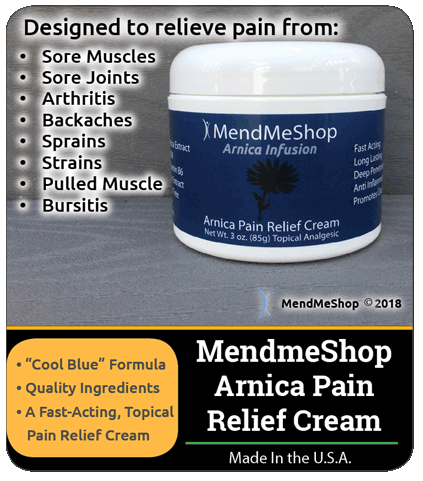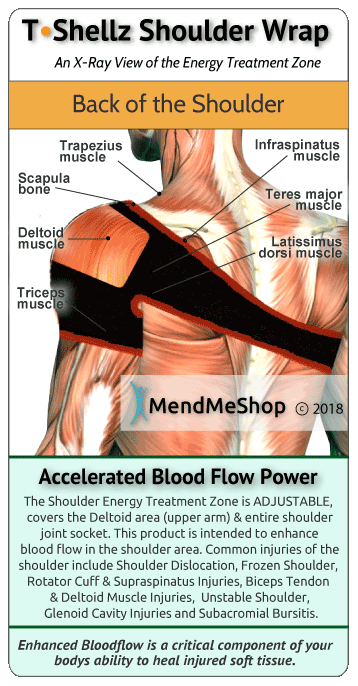|
|
Shoulder Tendonitis Symptoms & TreatmentsDealing with Shoulder Pain & Tendonitis InjuriesTendons are bands of connective tissue that join your muscles to your bones. This connection allows you to move your body when you contract your muscles. The rotator cuff (also called the rotor cuff) is made up of 4 tendons located at the outside edge of your shoulder that form a "cuff" around the glenohumeral joint. These tendons, along with other soft tissue in the joint cavity, work together to attach the humerus (upper arm bone) to the scapula. When the shoulder muscles contract, these tendons; the supraspinatus, the infraspinatus, the teres minor and the subscapularis, allow your shoulder to complete its complex set of movements and move your arm. Shoulder tendonitis (tendinitis) usually causes pain and tenderness in the side and front of the shoulder. If you have shoulder tendonitis you may also have an inability to move your arm or hold it in different positions. Other common symptoms of this injury include pain or a dull ache in your shoulder and/or upper arm, pain when using your arm (either reaching around your body to the front, side, back or overhead), pain that radiates down your arm. The injured area could be red, swollen, or hot the the touch. Severe tendonitis in your shoulder (possibly from a tendon rupture or ruptured tendon) could result in pain when sleeping at night (especially when laying on the affected shoulder), increased pain first thing in the morning, and general weakness or instability in your shoulder joint. Chronic tendonitis develops over time and generally results from long term repetitive use of one or some of the rotator cuff tendons. Common activities that cause chronic tendinitis in the rotor cuff are activities like weight lifting, painting, and repetitive throwing in sports. With both types of tendinitis, the condition can be very painful and will likely have periods where it flares up, and periods when it feels somewhat better after it has been rested or the repetitive motion that irritates it has been stopped. Although tendinitis can occur in any of the rotator cuff tendons, the supraspinatus tendon is most susceptible to injury. Due to its location at the top of the shoulder, between the joint cavity and the acromion, the tendon is at risk of irritation, wear and tear, and/or impingement. It functions to allow the arm to abduct (move away from the body) and is used for many daily activities which can lead to chronic tendinitis. Rotator cuff tendinitis is also known as Swimmer's Shoulder, Pitcher's Shoulder or Tennis Shoulder.Anyone can suffer from tendonitis, but it's most common in adults due to degeneration of tissue as we age. Over time the tendons in the foot will wear down resulting in something called degeneration. This is where the fibers in your tendons will become more weak - it's just a natural process that happens as we age. Overuse Tendonitis of the Shoulder Repetitive motion (overuse) of the tendons in your shoulder can lead to irritation, bruising or fraying of the tendon fibers. This can cause shoulder pain and weakness in the joint. There are 2 main ways that over use can lead to shoulder tendonitis - through your job or any regular sport / activity that you perform. Those affected by their job may be holding their arm in the same position for an extended period of time (ie. computer workers or hair stylists), or using their arm over their head on a regular basis (ie. painters and carpenters) (reference: 1). Many athletes performing repetitive overhead movements are also more likely to get shoulder tendonitis. This happens most to athletes that play baseball, racket sports (tennis), swim or repeatedly lift weights (reference: 1). Calcific TendonitisCalcific tendonitis refers to a build-up of calcium in the rotator cuff that leads to a bone spur in the shoulder. This condition is often aggravated by an existing injury, such as Impingement Syndrome or tendonitis in the shoulder. When calcium builds up in the area, pain results from acute inflammation. Fluid movement of the joint is reduced. Calcium is deposited in the rotator cuff, between the humerus and acromion bones inhibiting the normal, friction-free movement of the joint. Impingement or tendonitis, which reduce the mobility of the joint lead to degenerative change and calcium deposits (bone spurs) in the shoulder joint. Symptoms of a Ruptured Tendon in the ShoulderIf you suffer from a shoulder tendon rupture (ruptured tendon) you might hear a sudden pop or experience severe pain immediately after you're injured. Tendon ruptures usually only happen from accidents or pre-disposed conditions that weaken the tendon - like repeated anti-inflammatory injections, calcium deposits (bone spurs) in and around your shoulder joint or other diseases (ie. gout). Tendon ruptures usually require surgery to re-attach the tendon to the bone or bring both sides of the tear together, and if left untreated can result in permanent disability in your shoulder. Symptoms of Rotator Cuff TendonitisThe symptoms of chronic rotator cuff tendinitis usually begin with mild pain in the shoulder that gradually becomes worse. Acute symptoms will come on more suddenly. If you have rotator cuff tendinitis, some possible symptoms may be:
Causes of Rotator Cuff Tendonitis
 What Kind Of Shoulder Tendonitis Do You Have?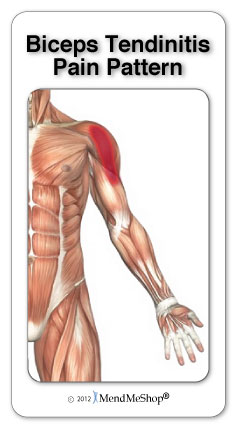 The most common forms of shoulder tendonitis are bicep tendonitis and supraspinatus tendonitis (rotator cuff tendonitis). Both of these types of tendonitis can happen as a result of tendon tissue being pinched by surrounding structures. It's easy to get shoulder tendonitis mixed up with other shoulder injuries, like shoulder bursitis, because other shoulder injuries have many of the same symptoms as shoulder tendonitis. If you have bicep tendonitis you'll usually feel the most pain in the front of your shoulder. This pain will get worse when you lift your arm overhead. You may also feel pain that shoots down your upper arm, and it's possible that you hear a popping or snapping noise when moving your arm / shoulder (reference: 1). If you have supraspinatus tendonitis (rotator cuff tendonitis) you'll feel pain in the front of your shoulder that may radiate down the side of your arm. You will also feel pain when lowering your arm from a raised position. Shoulder Tendonitis = High Risk of Other InjuriesIf left untreated, your shoulder tendonitis can turn into a chronic condition, like tendinosis (tiny tears in your shoulder tendon that aren't swollen or inflamed) or tendinopathy. Some people may have shoulder tendonitis as a result of an on-going shoulder impingement syndrome that has carried through for most of their lift. Or they may initially notice their tendonitis but later suffer from the symptoms of impingement syndrome. When you have shoulder tendonitis you usually want to rest your shoulder and avoid activities that make your pain worse. Reducing your mobility completely can result in another condition called frozen shoulder. Impingement SyndromeImpingement syndrome happens when the tendons or bursa in your shoulder get caught by the bones in your shoulder. Over time if left untreated impingement syndrome can result in shoulder tendonitis, bursitis and can cause tearing in your rotator cuff tendons. Like shoulder tendonitis, impingement syndrome can happen from repeated overhead activity or movement like painting, lifting, swimming and any other overhead sport. There are generally 3 stages in impingement syndrome: Stage 1 (pain, swelling and inflammation in the rotator cuff tendons), Stage 2 (rotator cuff tendonitis) and Stage 3 (tendon tissue catching under your bone resulting in immobility and loss of function in your shoulder). Each stage will generally affect a different age group, which is why this condition is thought to progress over time. Stage 1 usually affects individuals younger than 25 years old, Stage 2 affects individuals between the ages of 25 and 40, and Stage 3 affects individuals 40+ (reference: 1). 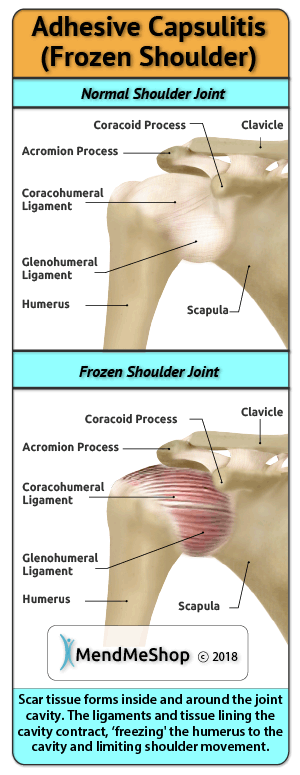 Frozen ShoulderFrozen shoulder (also known as "adhesive capsulitis") is signified by pain and stiffness in the shoulder joint; limited range of motion and pain while sleeping. This is a condition that commonly occurs in older athletes. Frozen shoulder is five times more common in people with diabetes, though the reason for this is unknown. A lining of fibrous tissue, known as a capsule, surrounds the shoulder joint. The capsule is fully stretched when the arm is raised above the head, and it hangs down as a small pouch when the arm is lowered. Frozen shoulder happens when this lining becomes thickened and swollen. It's possible that frozen shoulder will happen as a result of a previous injury (like shoulder tendonitis), but it can also happen for no apparent reason or may be triggered by a mild injury in the shoulder area. There are 3 phases to this condition: "Freezing" (general pain, swelling and inflammation), "Frozen" (stiffness in your shoulder) and "Thawing" (recovery as pain eases and most of the movement returns). This process will take some time to get through, and can sometimes take as long as 2 or more years to complete. Shoulder Tendonitis Conservative Treatment OptionsIf you have a rotator cuff tendinitis rest is highly recommended. Avoid activities that cause pain or may have caused the inflammation and begin cold compression treatments as soon as possible. During the healing process, scar tissue builds on affected rotator cuff tendons - the supraspinatus, subscapularis, teres minor and infraspinatus tendons. This scar tissue can cause the tendon to thicken, decreasing the area in the subacromial space and increasing the chance of impingement. In addition, scar tissue can bind the tendons and ligaments together within the joint capsule and surrounding the rotator cuff. The inflexible scar tissue limits the movement of these tendons and ligaments that were once elastic and allowed the shoulder its large range of motion. As a result, movement of the entire joint is limited making it difficult to lift your arm or to reach for objects. If left untreated, the shoulder may 'freeze' (a condition called frozen shoulder or adhesive capsulitis) altogether making movement impossible. At the very least, scar tissue leaves your tendon weaker than a healthy tendon, leaving your rotator cuff at greater risk of further deterioration and possible tearing. Once the inflammation of your tendinitis has been reduced through use of a Cold Compress or Ice Pack, nourishing and strengthening of the rotator tendons, muscles and surrounding area is recommended. Using the Shoulder TShellz Wrap® will speed your recovery and heal your rotator cuff more completely preparing it for strengthening exercises. Talk to your doctor or physical therapist to find out which exercises are appropriate for your situation. Conservative Treatment Step 1: Reduce The Initial InflammationInflammation is the body's natural response to an immediate shoulder injury and is a normal part of the healing process - helping to reduce tissue infection in the early stages of injury. Swelling, pain, heat sensation, redness, and loss of function are the main symptoms experienced. The combination of rest, topical pain relief cream and minor amounts of cold is the gold standard in medicine for minimizing tissue damage and reducing inflammation after injury or activity. It serves as a critical bridge into the next phase of the healing process. Conservative Treatment Step 2: Enhance Blood Flow to the Injured Soft TissueTendons,ligaments, cartilage, and some muscle fibres are dense tissues. As a result, they naturally receive limited blood flow and this is precisely why injuries to these tissues take so long to heal. The challenge is, how do you effectively increase blood flow to these tissues?
It is through the blood the body carries the nutrients and oxygen that injured tissues rely on for recovery.. It is well known that increased blood flow helps your body accelerate the healing process. This is why the TShellz Wrap® is such an important tool. The whole purpose of the wrap is to accelerate blood flow to soft tissue in the treatment area. The end result; you relax the blood vessels within soft tissues of the treatment area. The vessels will naturally expand and allow for more blood flow to reach the very tissues you are trying to heal. In addition, this process will help clear the area of toxins and excess fluid build up, thereby reducing inflammation. Who Should Use the TShellz Wrap®We recommend the use of a TShellz Wrap®:
Increased Blood Circulation = Increased Healing Rate What Else Makes the Shoulder TShellz Wrap® So Special?We believe the TShellz Wrap® to be one of the most effective treatments to stimulate blood flow to dense, injured tissues such as muscles, tendons, ligaments, and other similar tissues. We can promise that you will receive a product that is designed to be safe and does what it is supposed to do...quickly relieve pain and aid in the recovery from tendon, muscle and other soft tissue injuries. The unit plugs into a standard wall outlet to get its power. The nice thing about the power supply is that the same unit can be used in North America and overseas as well. It has the capability to operate between 110v and 230v. It has a special controller that can be set for 3 different power levels of application (3=High, 2=Medium, 1=Low). The cord is long so you can sit or lie comfortably and watch TV, read or surf the net while you're using it. Treatments are max 30 minutes in duration and the device can be worn over clothing. This allows you to use the device at work, at home, or really anywhere you have access to an electrical outlet. A Recap of the Benefits of the TShellz Wrap®..
When Should I Use My TShellz Wrap During the Day?The most common question we receive from individuals prior to purchasing is - how many times a day should I be using my shoulder wraps and when should I be using them? While treatment plans will differ for each individual and their specific injury, there are general guidelines that should be adhered to.
The Shoulder TShellz Wrap® would then be used:
Circulatory Boost = Greatly Increased Blood Flow in Your Injured Shoulder Stage 3 - In Between Treatments With TShellz Wrap®, Apply Our New Fast Acting Pain Relief Cream Called ARNICA INFUSIONDealing with aches and pains affecting the foot, ankle, leg, knee, hamstring, hip, back, arm, shoulder, elbow, wrist, or hand? If so, then applying the Arnica Infusion to any of these targeted areas will bring about fast relief from the pain and sore tissues. Simply apply a small amount of cream to the body and moments later, you will experience a soothing and comforting sensation over the area. Arnica Infusion is specially designed to relieve pain due to sore muscles and joints associated with arthritis, backaches, sprains, strains, and bruises. No matter if you are dealing with an acute injury, chronic pain, or a general "flare-up" - you will experience fast relief from pain and inflammation. This is a product that many of our current MendMeShop customers asked us to develop. So we focused our time and resources over the past few years and came up, with we believe, will be one of more effective, fast acting, topical pain relief creams on the market. You are likely familiar with some of the standard topical agents on the market as most of our customers use them. The are mass marketed and even found in most department stores now. Well, we are here to say that Arnica Infusion goes many steps beyond what they offer. Made in the USA at an FDA registered manufacturing facility, you can be assured that Arnica Infusion is both safe and effective. We only source top grade ingredients while implementing strict quality control checks during every step of the production process. Expect the same high quality that MendMeShop customers have been accustomed to since we started the company in 2005. The "Cool Blue" formula is the perfect balance between the smooth application of a cream and the effective absorbing factor of a gel. It is not too thick and not too thin - just the right texture. Best of all, it feels very nice on the skin! Each application of Arnica Infusion feels so comforting and soothing, we are certain it will become an item you will not want to live without. Conservative Treatment Tools Our Clients Have Used to Help |
   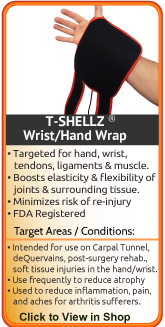    |








